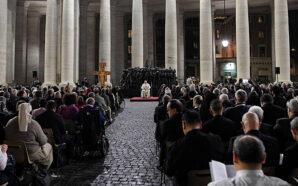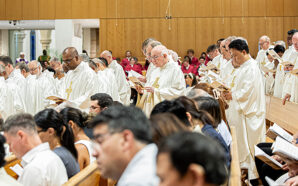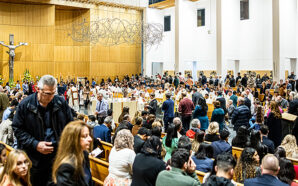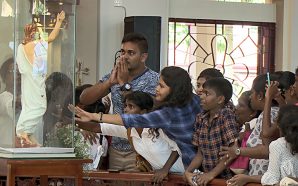Homily at the Mass of Christian Burial for Bishop Bede Heather
St Patrick’s Cathedral, Parramatta
4 March 2021
All I want is to know Christ and the power of his resurrection and to share his sufferings by reproducing the pattern of his death. That is the way I can hope to take my place in the resurrection of the dead.
These words, heard this morning, are taken from part of a letter Paul wrote to the Christian community in Philippi, sometime around 60. The whole letter, written possibly from Rome, exhorts the followers of Christ to rejoice regardless of circumstances, and to act always with humility and unity. Striving for unity, particularly, Christian unity was one hallmark of Bede’s episcopal ministry. He was at home with people of faith and those of no professed faith, with anxious agnostics and angry atheists. He put a very human face on the Church in our secular pluralistic society.
Humility was a constant virtue lived throughout his life. Sixteen times Paul uses the word ‘joy’ in his letter to the parishioners of that Roman colony. Our funeral Mass, where we will pray for the repose of Bede’s soul, should therefore be simple, humble, yet joyful. Paul’s letter also contains a warning regarding the dangers of legalism. Bede, like Paul, had his detractors, the temple police, more intent on the observance of the law than freedom of the Spirit. With these thoughts in mind we can begin to understand why Bede chose Philippians to be read at his funeral Mass.
This reading, and the Gospel proclaimed today, are perhaps the most subtle yet powerful homily Bede ever preached.
READ: Parramatta farewells its first Bishop: Bede Heather
RELATED: Images from the funeral Mass can be accessed here
Bede confirms his belief in the resurrection by choosing these four verses of the letter, and in the gospel proclaimed this morning – a strange gospel for a funeral Mass – Bede unashamedly reminds us that our baptismal commitment finds its fulfilment in service. It is a teaching Christians must live, from the bishop down to the youngest altar server. To those in public life, politicians and women and men serving as councillors, the service industry workforce, public servants, personnel in the armed forces, police force, young and old married couples, and those generous and brave seminarians who will willingly take Bede’s place in the ordained priestly ministry. If we are to be true followers of Jesus, we must do what Jesus asked us to do. He says in today’s gospel, “I have given you an example so that you may copy what I have done to you.” Bede, of course, was a teacher and he is teaching us from there even now.
Regarding humility mentioned in the Second Reading, some of the priests found it interesting that Bede moved around the diocese wearing the simple wooden cross you can see on the casket. It was held around his neck with what looked like venetian blind cord. I notice that official photos of bishops taken together with Pope Francis now have many bishops wearing wooden crosses. They can follow a trend. In this, Bede was ahead of his time. At the moment in Rome, I understand there is great demand for venetian blind cord.
Bede did not want to be buried from this great cathedral. To return to Philippians, in his humility he wanted to go from a more humble place, a simple, ordinary, parish church with a funeral presided over, not by a bishop, but by a simple, ordinary priest. That’s why he chose me.
But the funeral had to proceed from this place. It is the first and mother church of the diocese. There is so much of Bede alive and present here. He is everywhere. Bede favoured the name Parramatta for this diocese over the competing, Cumberland. The great organ he acquired from London; this is the place where he was installed, where he took canonical possession of the diocese on May 19, 1986 as the First Bishop of Parramatta and, of course, he watched the fire take hold of the cathedral on that eventful day in February 1996.
I penned an article about the fire for a Melbourne periodical called The Summit. I wrote, “Our first parish gathering was the night after the fire. My memory of that night is of Bede Heather looking taller and in control. He was like a strong father surrounded by adult children who were desperately in need of reassurance.” Flawed like all of us, he could be definite, even stubborn. Sometimes he was very formal. He was always the gentleman. As a bishop he was a man of his time, but on the cusp of a new era.
RELATED: The funeral Mass booklet can be accessed here
After that parish meeting, Bede said to me, “Tomorrow we will wait on the Lord Mayor”. He wanted the Council to block off Marist Place, the road outside the cathedral. “Wait on the Lord Mayor?” I thought I was talking to Archbishop Polding. John Bede Polding, of course, opened the first church on this site in 1836. Incidentally, it is the anniversary of Polding’s ordination today, two hundred and two years ago. Can I be brave and say Polding was responsible for the proliferation of the name ‘Bede’ of Bede’s generation? When we were walking back from the Lord Mayor’s office, I said to Bede, “I am going to the court house. I want to see the arsonist who is appearing in the court today.” Bede stopped short and formally said to me, “John, go down into the cells and tell him he is forgiven.”
I am here to tell you that forgiveness was the furthest thing from my mind. But, I thought, “What a good idea! By going into the cells below the court I can get a closer look at the scoundrel.” I had in mind that dramatic photo of John Paul II and Mehmet Ali Agca in 1981 in the cells following his attempt to assassinate the Pope. If I could get close enough to the rogue I was even willing to break the fifth commandment. But, I told Jason, as Bede instructed me, that the bishop said he was forgiven.
When I returned to the entrance to the court house, a large contingent of media was present, cameras, microphones, about 40 of them talking over each other and shouting questions at me. One journalist asked, “You met with the arsonist, what did you say to him?”
“I told him he was forgiven.”
“Why did you say that?”
“I heard myself say, as if butter wouldn’t melt in my mouth, and in my most pious voice, ‘I preach forgiveness, so I must practice what I preach’.”
The hypocrisy was too much, even for me. I feared God might strike me dead. Talkback radio that night was critical of the bishop. “Who does this bishop think he is to forgive the arsonist who burnt down our cathedral?”
To forgive each other as soon as a quarrel begins was always Bede’s preference. It was a revelation to him that the community – even those educated in Catholic schools – did not honour or understand this basic, fundamental Christian mandate. Paul failed in this matter with the church in Philippi, so I can’t understand why Bede was surprised when he was so viciously attacked by Catholics when he preached this message of forgiveness. His openness to forgiving people who had failed, sometimes proved his downfall.
In choosing Aldo Giurgola, the architect for the parliament house in Canberra, as architect for the rebuilding of this cathedral, Bede was authentically following his episcopal motto, Sacrosanctum Concilium. In that document, SC, it is written that it is the desire of the Church “that all the faithful should be led to that full, conscious, and active participation in liturgical celebrations which is demanded by the very nature of the liturgy”. Parliament at Question Time is the great example of full, conscious and active participation. One can notice the likeness of the architecture in this sacred space with the Parliament House in Canberra. Again, Bede was ahead of his time. But not quite. From his Roman days he was familiar with the basilica of Santo Stefano Rotondo, Santa Costanza on the Via Normantana and he loved San Vitale in Ravenna and of course Charlemagne’s palatial chapel in Aachan. All of these historical churches are “in the round”, not dissimilar to this sacred space.
Bede’s ecclesiology was that of Servant Church. This found expression in his attendance at the Palm Sunday Peace Marches. As Holy Week began Bede would be part of the 300,000 people in a ‘protest for peace’. He was a visual aid indicating Catholics could work with other Christians and that Catholics should be involved in social justice issues. He was criticised for this activism. He wrote in an article for the Catholic Historical Society that Cardinal Freeman tolerated his participation in silence. His most enduring legacy was his dialogue with the Baptist church.
The first diocesan office was in the presbytery at Blacktown. That was an unsuitable arrangement and Bede and his two staff upsized into what was a parish-owned fibro house located on a sort of alley linking Main Street with Bungarribee Road. It has the pretentious name of Hereward Highway. The house was approached through an overgrown lawn and Bev Driver, Bede’s secretary, remembers there were half a dozen to ten Coca Cola bottles filled with water lying around on their sides. A strange fashion accessory for a bishop’s office. The house had a wire screen door where it was safer to lift the flapping wire and walk through than to attempt to open the door with the screws missing from the bottom hinge.
“Well, what do you think?” Bede asked me on my first visit.
“It looks like squatters are about to move in”, I replied. “What gives with the Coca Cola bottles lying on the lawn?”
“There’s a belief”, Bede said, “that water in bottles will stop dogs from using the lawn as a convenience”.
The whole arrangement was humility on steroids.
In this precinct, Bede set up a Marriage Tribunal, Confraternity of Christian Doctrine, Finance Committee, Centacare and a diocesan Catholic Education Office. In November 1986 Pope John Paul visited the Diocese. Bede was his official host riding in the popemobile. But not all events were occasions for joy. The story of the Gerard Majella Brothers is a painful chapter for all. And Bede facing the Royal Commission at nearly 88 years of age was not the highpoint of his life. The Priests’ House of Prayer built at East Kurrajong was a special work dear to his heart. His inclusiveness meant he welcomed priests born overseas and started the annual meetings of Anglican and Catholic clergy leading to the inaugural annual law service to mark the beginning of the law term. Ever the teacher, he set up the Parramatta Pastoral Institute at Blacktown to provide spiritual and theological formation for lay persons. Following the International Year for Handicapped Persons in 1982, Bede began a professional outreach to handicapped persons. And, like Polding, Bede had a special interest in the indigenous population in the Diocese setting up the Aboriginal Catholic Ministry. Added to this were other initiatives such as single parents’ accommodation, and HIV Aids ministry. He was Chairman of the Board of Mount Druitt Hospital and established a stand-alone palliative care facility at Mount Druitt. The list goes on. He was a visionary.
At Bede’s 90th birthday celebration at Blacktown, his words had the ring of a final will and testament. He spoke of the Olive Tree as a symbol of his life. He wrote, “St Paul and St John have each described in glowing terms the future hope of Christians. I just hope that when I close my eyes for the last time there will be a vision of light and two olive trees, one on the right and one on the left.” That is the symbolism of the olive trees at the sides of the ambo, the place from where the scriptures are proclaimed. And, of course, Bede was a scripture scholar. Only two weeks ago he published twenty-nine pages of notes on the Book of Revelation, ending with Maranatha, “Come Lord”.
Even though he struggled for breath, he was conversing up to the last minutes of his life. He knew he was dying and many people came to say goodbye. He presided over his own death.
Bede closed his eyes for the last time at sunrise on Thursday February 25. When I arrived at St Ezekiel’s, some time later, his body was still warm. And together with Leona and Bev Hackett, we prayed, “Receive his soul and present him to God the Most High”.
In this Mass we pray that angels will receive his soul and present him to God the Most High. Today we hand Bede Vincent Heather over to God – and the historians.
Monsignor John Boyle is a priest of the Diocese of Parramatta.








